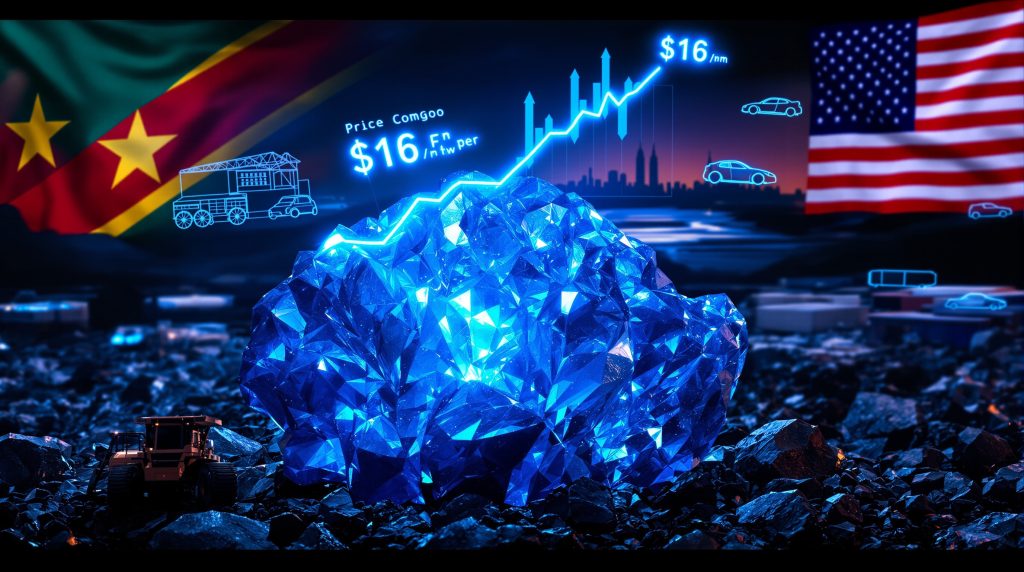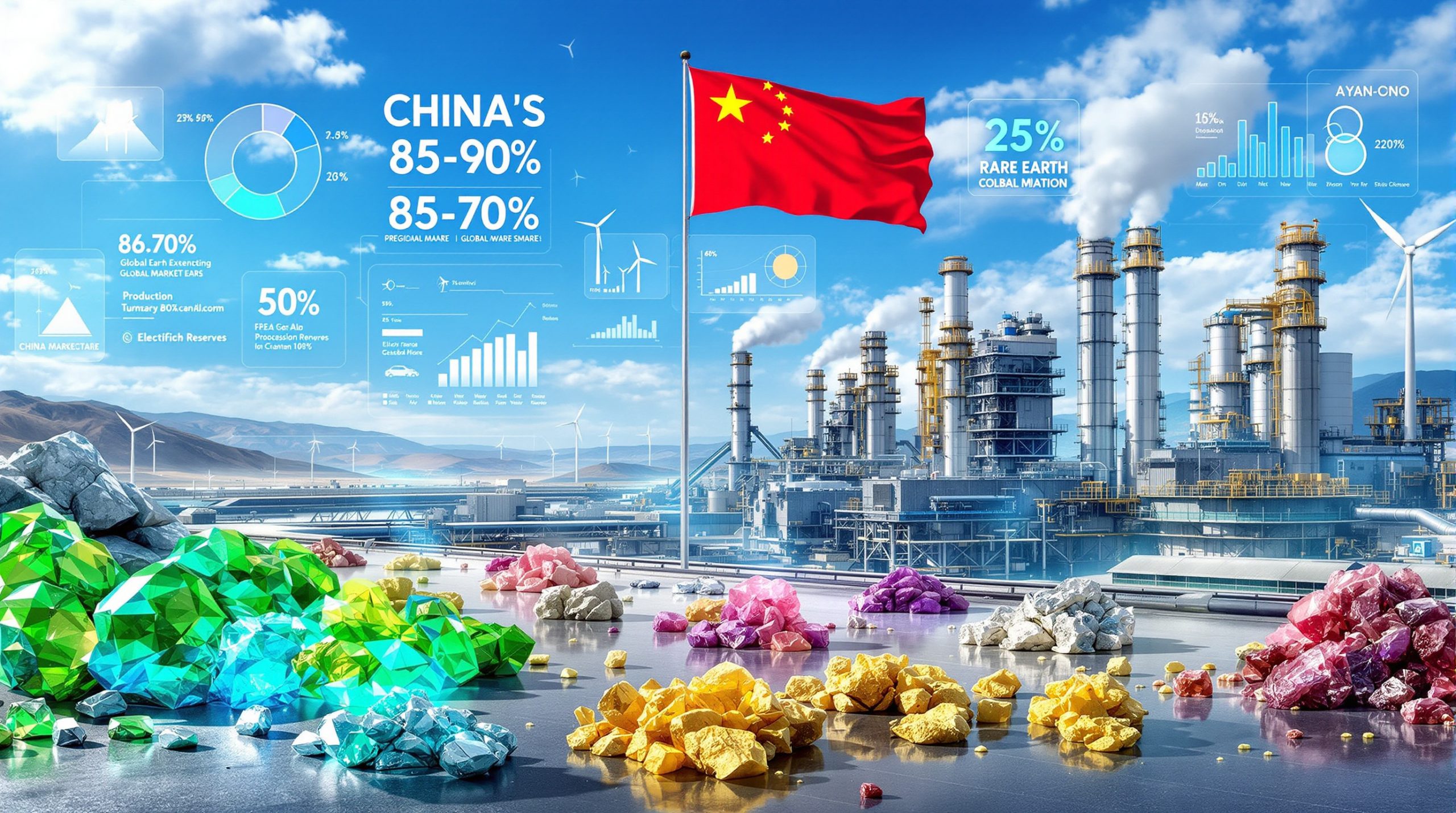The Geopolitical Storm Driving Cobalt Prices Higher in 2025
The cobalt market is experiencing significant upward pressure in 2025, with prices climbing dramatically due to a perfect storm of geopolitical factors, strategic stockpiling initiatives, and tightening supply restrictions. These developments are fundamentally reshaping the global supply chain for this critical battery metal at a time when demand continues to accelerate.
Industry analysts point to several concurrent factors creating this market dynamic: US defense stockpiling after decades of inactivity, extended export restrictions from the Democratic Republic of Congo (DRC), and strategic positioning by major world powers seeking to secure access to this vital resource. Together, these forces have pushed cobalt prices significantly higher this year with potentially lasting implications for critical minerals in energy transition.
US Strategic Stockpiling Creates New Market Force
Pentagon's First Major Cobalt Purchase Since the 1990s
In a significant shift in resource security policy, the US Defense Logistics Agency has launched an ambitious program to acquire up to 7,500 tonnes of cobalt over the next five years. With an allocated budget of approximately $500 million, this marks the Pentagon's first major cobalt acquisition initiative since the 1990s, signaling growing concerns about critical mineral supply chains.
"This strategic stockpiling program represents Washington's most concrete action to date in securing battery metals," notes commodities analyst Richard Thompson of Global Resource Partners. "It follows years of policy discussions about reducing dependency on foreign supply chains for critical materials."
The timing of this initiative aligns with broader efforts to rebuild domestic manufacturing capacity and strengthen resource security across industrial sectors vital to both economic and military interests.
Breaking China's Processing Dominance
This procurement initiative clearly demonstrates the United States' determination to reduce its vulnerability to China's dominance in cobalt processing, which currently accounts for approximately 80% of global capacity according to International Energy Agency data.
To achieve this goal, the US strategy focuses on securing alternative supply channels through partnerships with Western-aligned producers. Among the suppliers approached for the strategic stockpile are major mining companies including Vale SA, Sumitomo Metal Mining, and Glencore's Nikkelverk processing facility in Norway.
Industry observers note that by deliberately avoiding Chinese-processed material, the US is establishing a parallel supply chain that can function independently of Beijing's influence. This represents a significant pivot in critical minerals strategy and could accelerate investment in processing capacity outside China.
DRC Export Restrictions Transform the Supply Landscape
Extended Ban Disrupts Global Flows
The Democratic Republic of Congo, which accounts for approximately 77% of global cobalt production according to the US Geological Survey, has extended its ban on cobalt exports until at least September 21, 2025. This extension represents a significant disruption to global supply chains, effectively removing the majority of newly mined cobalt from international markets.
The DRC government initiated the export ban to encourage domestic processing and capture more value from its mineral resources. While this policy aims to develop local industry, its immediate effect has been to tighten global supplies and support higher prices.
Transition to Quota System Expected
Market analysts anticipate that following the current export ban, the DRC government will implement a quota system to regulate cobalt exports. This regulatory approach would allow for more controlled flows of material while maintaining government oversight of this strategic resource.
"Even when shipments eventually resume, tighter restrictions are expected to limit the volume of cobalt entering the global market," explains mining sector economist Maria Rodriguez. "The DRC has studied how other resource-rich nations have implemented export controls, and they're likely to follow a similar model of gradually increasing quotas based on domestic processing capacity development."
Inventory Buildup Creates Delayed Impact
Despite the export ban, cobalt inventories continue to accumulate within the DRC. Miners have maintained production levels, creating a growing stockpile of material awaiting export authorization. However, industry experts note that even after the ban is lifted, it could take until early 2026 for this material to reach major processing hubs in China.
This timeline creates a significant lag between production and market availability, providing near-term support for cobalt prices even if the export policy changes. The logistics of moving material from mine sites to processing facilities, coupled with the backlog of inventory, means that supply constraints will likely persist through much of 2025.
Dramatic Price Movements Reflect Market Tension
Metal Price Trajectory in 2025
Cobalt metal prices have demonstrated remarkable volatility in 2025, rising from approximately $10 per pound in February to around $16 per pound by March. This 60% increase over a single month reflected the market's sudden recognition of the combined impact of US stockpiling and DRC cobalt export ban.
Since reaching this higher level, prices have stabilized in a new trading range, reflecting the market's adjustment to supply constraints and strategic buying. This price stability at elevated levels suggests that market participants view the current supply-demand dynamics as a medium-term reality rather than a temporary disruption.
Hydroxide Payables Increase Significantly
The cobalt hydroxide market, which represents an intermediate product in the supply chain, has seen payables climb substantially from 60% to 87%. This increase in payables indicates strengthening demand for cobalt feedstock among processors and refiners, despite the challenging supply environment.
The hydroxide market is particularly significant as it represents the form in which most DRC-produced cobalt initially enters the supply chain before further processing. The dramatic increase in payables reflects both current supply tightness and expectations of continued constraints ahead.
Mining Companies Positioned to Benefit
Key Industry Players in Focus
The cobalt market features several prominent producers who are positioned to benefit from the current price environment. Glencore and CMOC Group stand out as particularly significant players in the global cobalt supply chain, with both companies having substantial operations in the DRC.
While these major producers face challenges from the export ban, they also stand to benefit from higher prices once shipments resume. Their established positions in the market and vertical integration into processing provide advantages in navigating the complex regulatory environment.
Market Share Distribution and Competitive Positioning
CMOC has emerged as the largest cobalt producer globally, commanding approximately 35% of market share through its extensive operations in the DRC, particularly its Tenke Fungurume mine. This dominant position gives the company significant influence in the market, though it also creates exposure to DRC regulatory risk.
Despite CMOC's market leadership, some analysts prefer Glencore's investment profile due to its more diversified portfolio across multiple commodities and geographies. While Glencore maintains substantial cobalt production, particularly from its Katanga operation, it balances this with significant copper, nickel, zinc, and coal assets globally.
Comparative Advantages in a Constrained Market
While CMOC benefits from its market-leading position in cobalt production, Glencore offers investors exposure to cobalt price increases while providing risk mitigation through its diverse commodity mix. This diversification becomes particularly valuable during periods of market volatility or when specific commodity sectors face challenges.
"Glencore's vertical integration from mining through processing to marketing gives it unique visibility across the entire supply chain," notes mining sector analyst James Richardson. "This allows the company to optimize its position regardless of where bottlenecks occur in the market."
Duration of Upward Price Pressure
Near-Term Support Factors
The combination of US strategic stockpiling and DRC export controls is expected to maintain support for cobalt prices through the fourth quarter of 2025. These dual factors—one demand-driven and one supply-restricted—create a favorable environment for sustained price strength.
Market participants are particularly focused on the potential timeline for DRC export policy changes and the implementation details of any quota system. These regulatory decisions will significantly influence how quickly accumulated inventory can reach international markets.
Long-Term Market Dynamics
Looking beyond 2025, the cobalt market will likely be shaped by several competing forces:
- The pace and scale of electric vehicle adoption globally
- Technological developments in battery chemistry that may reduce cobalt intensity
- New production capacity coming online outside the DRC
- The evolution of DRC export policies and governance
Each of these factors carries substantial uncertainty, making long-term price forecasting particularly challenging. However, the structural importance of cobalt to high-performance batteries suggests continued strong demand fundamentals, while supply concentration in the DRC creates ongoing vulnerability to disruption.
Implications for Battery Supply Chains
Critical Component for Energy Transition
Cobalt remains an essential component in high-performance lithium-ion batteries, particularly for applications requiring high energy density and thermal stability. The current supply constraints highlight the vulnerability of battery supply chains to disruptions in critical mineral availability.
Battery manufacturers and automakers are closely monitoring the situation, as cobalt content represents a significant portion of battery cell costs. Sustained high prices could potentially slow the decline in electric vehicle costs that has supported market growth in recent years.
Potential for Accelerated Substitution
Persistent high cobalt prices could accelerate efforts by battery manufacturers to develop and deploy lower-cobalt or cobalt-free battery chemistries. Several major automakers and battery producers are already investing heavily in alternative technologies to reduce their exposure to cobalt supply risks.
Lithium iron phosphate (LFP) batteries, which contain no cobalt, have already gained significant market share in certain applications, particularly in China and for standard-range vehicles. High-nickel cathode formulations that minimize cobalt content are another pathway being actively pursued by manufacturers seeking to reduce dependency.
Regional Supply Chain Development
The current market dynamics may accelerate efforts to develop more regionalized battery supply chains, particularly in North America and Europe. These initiatives aim to reduce dependence on both DRC-sourced cobalt and Chinese processing capacity.
Recent policy initiatives, including the US Inflation Reduction Act and European Critical Raw Materials Act, provide financial incentives and regulatory frameworks to support domestic processing capabilities. These efforts, alongside Trump's critical minerals order, could fundamentally reshape the cobalt supply chain over the coming decade, though near-term reliance on existing channels remains high.
FAQ: Understanding the Cobalt Market in 2025
Why is cobalt considered a strategic mineral?
Cobalt is designated as a strategic mineral due to its essential role in advanced technologies, particularly high-performance batteries for electric vehicles and energy storage systems. Its limited production geography and processing concentration make it vulnerable to supply disruptions, while its importance to both civilian and military applications elevates its strategic significance.
Beyond batteries, cobalt is vital for superalloys used in jet engines, medical implants, and various defense applications. This diversity of critical uses, combined with limited substitutability in many applications, makes securing reliable supply chains a national security priority for many countries.
How does cobalt mining impact local communities in the DRC?
Cobalt mining in the DRC has complex social impacts. Large-scale industrial operations provide formal employment and economic development but may displace communities. Artisanal mining offers livelihoods for hundreds of thousands but often operates under hazardous conditions with inadequate safety measures.
Child labor concerns have received significant attention in artisanal mining sectors, prompting industry initiatives to improve traceability and ethical standards. Major mining companies and technology firms have implemented various certification schemes to ensure responsible sourcing, though challenges remain in fully addressing social and environmental impacts.
What alternatives exist to reduce dependence on cobalt?
Battery manufacturers are pursuing several strategies to reduce cobalt dependence, including:
- Developing lithium iron phosphate (LFP) batteries that contain no cobalt
- Creating high-nickel cathode formulations that minimize cobalt content
- Researching solid-state battery technologies that may eliminate the need for cobalt
- Improving recycling technologies to recover cobalt from used batteries
Each approach involves trade-offs in performance, cost, and technological readiness. While LFP batteries are already commercially deployed at scale, particularly in China, they typically offer lower energy density than cobalt-containing alternatives. High-nickel formulations maintain better energy density but may face challenges with thermal stability and cycle life.
How might the cobalt market evolve beyond 2025?
The long-term outlook for cobalt will depend on the balance between growing demand from battery applications and potential constraints from technological substitution. Supply diversification efforts, including new projects in Australia, Indonesia, and North America, may reduce market concentration. Meanwhile, improved governance in the DRC could stabilize the primary source of global production.
Recycling represents another significant factor in future market dynamics. As the first generation of electric vehicle batteries reaches end-of-life, recovery of cobalt from these sources could provide a growing secondary supply that reduces dependence on newly mined material. Current recycling technologies can recover over 95% of cobalt from battery materials, though collection infrastructure remains a challenge.
Global Implications of Cobalt Market Dynamics
The ongoing transformation of the cobalt market represents more than just a commodity price story—it reflects broader geopolitical competition for control of critical mineral supply chains essential to energy transition and technological leadership. As nations and corporations position themselves strategically in this market, the impacts will extend beyond immediate price effects to shape battery metals investment outlook and international relations in the years ahead.
For investors, battery manufacturers, and policymakers alike, understanding these complex dynamics has become essential to navigating the challenging landscape of cobalt blue expansion in an increasingly resource-competitive world.
Looking to Capitalize on the Next Major ASX Mineral Discovery?
Gain instant alerts on significant mineral discoveries like cobalt with Discovery Alert's proprietary Discovery IQ model, transforming complex data into actionable investment insights. Explore how major mineral discoveries can lead to exceptional returns and position yourself ahead of the market with a 30-day free trial.




